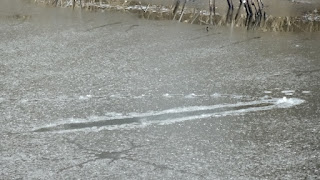Because so much insulating snow came down early in November and piled up repeatedly throughout winter . . . soil frost depth is minimal at this time. With all the moisture in the ground, it should be a good year for wildflowers!
4/02/2023
blizzard and frost depth
2/02/2023
log in deep snow
The pond is covered by more snow than we have seen at one time in the last decade. This area has an average of about 50 inches of snow each winter season. By the end of January, we had more than that. The log and the big rock are barely visible, but we can see many tracks of the critters who walk about.
12/30/2022
12/20/2022
logs in snow
10/12/2022
first snow 2022
Snow overnight. The log is totally exposed, because we are down more than 8 inches of precipitation.
12/23/2021
ice holes on pond
Cold, grey, blustery weather on the pond.
The water is covered by a thick layer of ice and snow drifts. Where the ice is visible between the drifts, a few holes break the smooth solid sheet. These seem to form where plant matter floating close to the surface or a submerged rock interrupted the process of liquid freezing to solid.
12/12/2021
11/14/2021
log in first snow
Overnight, we had the first snow of this season. On the pond, the water is high and the log was frosted with a little coat of white 'frosting'. The reeds are still green, but weakening and leaning sideways with the weight of moisture. The turtles who sun themselves on the log in summer are hibernating now. (see Surviving Below Freezing, 10/31/2020)
1/28/2021
11/22/2020
tracks, cracks, marks, mysteries
6/07/2020
thistle
We noticed this rosette among the ground clutter after the snow melted. Through May, it resumed vegetative growth. It is growing tall now, and branching out to produce numerous large flower heads.
This particular plant is just a lot of green now, hiding among more green.
But when it finally blossoms, you will not be able to miss the deep purple magenta flowers!
After blooming and setting seed the whole plant will die, thereby completing the life cycle.
But this plant can produce 120,000 seeds that could germinate this season and form little rosettes to wait out winter. Rather than allow this species to spread and become a nuisance in the pond area, DNR recommends control before flowering. We will enjoy the beginning of flowering and try to cut off development of any seeds.
2/29/2020
Chickadees at feeder over the pond
Black-capped Chickadees stay in Minnesota all winter. They eat seeds and insects or larvae when they can find any. They come to feeders where I offer sunflower seeds, safflower seeds, and peanut chips. This feeder hangs over the pond with an extra branch for the birds to perch on.
From November to April I watch, count, and report the birds I see as a citizen scientist. Cornell Lab of Ornithology is replete with data and information about birds. https://www.birds.cornell.edu/home
This pond is covered with snow, and a layer of ice under that. The turtles are hibernating below in the mud. The muskrats are snug in their burrows. It looks quiet and peaceful on the pond, but there is a lot going on in all seasons.
2/21/2020
snowy pond February
How different the same view looks in winter! Still, we see evidence of critters who live at the pond by their tracks in the snow.
2/10/2020
feeding birds on the pond
Chickadees, house finches, juncos, and even downy woodpeckers venture out of the trees nearby to take seed at the feeder next to the pond.
1/18/2017
3/23/2016
3/04/2016
a murder of crows

This hawk was gliding over the feeder garden looking for breakfast. The American Crows, who had been snatching peanuts from the tray feeder, gave chase. The hawk landed on a nearby roof. The crows dive-bombed in an effort to scare the hawk away. The hawk calmly waited, squawked a few times, then lifted off towards the river for a better chance at hunting.
1/08/2016
snow on Joe Pye Weed
The seedheads of Joe Pye Weed stand at the edge of the woods. When nibbling these seeds, the Goldfinches nearly disappear by blending in with the dried leaves and seed pods. With a blanket of sticky snow, the pods became "cotton balls" overnight!
12/29/2015
insulation for insects
(See "insect picnic" posted on 7-20-15)
Now, after a few more inches of snow, any insects or larvae still nestled in the trough will be cozy with a white blanket to insulate them; later, the birds will surely find nourishing meals there.
12/27/2015
critter tracks
Now that some snow blankets the ground, we can easily see tracks in the woods. Rabbits, grey squirrels, red squirrels, mice, chipmunks, various birds, and white-tailed deer left tracks -- visible today as the sun lowered in the west. Even the neighborhood cat made her mark while searching around the brush pile.






















